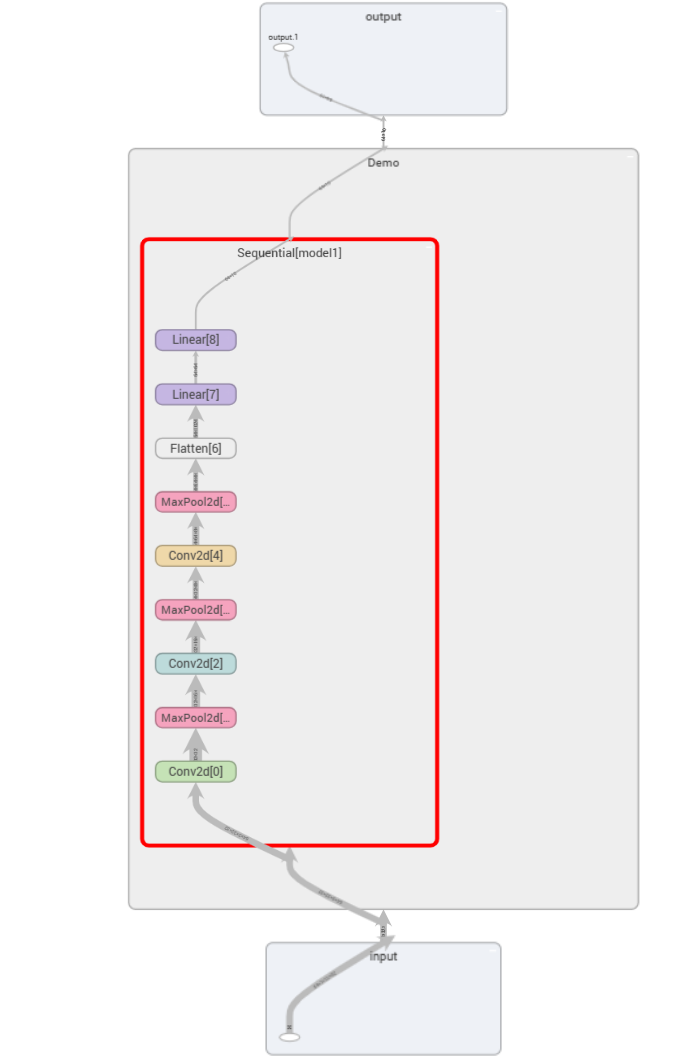深度学习(十二)——神经网络:搭建小实战和Sequential的使用
一、torch.nn.Sequential代码栗子
# Using Sequential to create a small model. When `model` is run,
# input will first be passed to `Conv2d(1,20,5)`. The output of
# `Conv2d(1,20,5)` will be used as the input to the first
# `ReLU`; the output of the first `ReLU` will become the input
# for `Conv2d(20,64,5)`. Finally, the output of
# `Conv2d(20,64,5)` will be used as input to the second `ReLU`
model = nn.Sequential(
nn.Conv2d(1,20,5),
nn.ReLU(),
nn.Conv2d(20,64,5),
nn.ReLU()
)
-
在第一个变量名model中,依次执行
nn.Convd2d(1,20,5)、nn.ReLU()、nn.Conv2d(20,64,5)、nn.ReLU()四个函数。这样写起来的好处是使代码更简洁。 -
由此可见,函数\(Sequential\)的主要作用为依次执行括号内的函数
二、神经网络搭建实战
采用\(CIFAR10\)中的数据,并对其进行简单的分类。以下图为例:

- 输入:3通道,32×32 → 经过一个5×5的卷积 → 变成32通道,32×32的图像 → 经过2×2的最大池化 → 变成32通道,16×16的图像.... → ... → 变成64通道,4×4的图像 → 把图像展平(Flatten)→ 变成64通道,1×1024 (64×4×4) 的图像 → 通过两个线性层,最后\(out\_feature=10\) → 得到最终图像
以上,就是CIFAR10模型的结构。本节的代码也基于CIFAR10 model的结构构建。
1. 神经网络中的参数设计及计算
(1)卷积层的参数设计(以第一个卷积层conv1为例)
-
输入图像为3通道,输出图像为32通道,故:\(in\_channels=3\);\(out\_channels=32\)
-
卷积核尺寸为\(5×5\)
-
图像经过卷积层conv1前后的尺寸均为32×32,根据公式:
\[H_{out}=⌊\frac{H_{in}+2×padding[0]−dilation[0]×(kernel\_size[0]−1)−1}{stride[0]}+1⌋ \]\[W_{out}=⌊\frac{W_{in}+2×padding[1]−dilation[1]×(kernel\_size[1]−1)−1}{stride[1]}+1⌋ \]可得:
\[H_{out}=⌊\frac{32+2×padding[0]−1×(5−1)−1}{stride[0]}+1⌋=32 \]\[W_{out}=⌊\frac{32+2×padding[1]−1×(5−1)−1}{stride[1]}+1⌋=32 \]即:
\[\frac{27+2×padding[0]}{stride[0]}=31 \]\[\frac{27+2×padding[1]}{stride[1]}=31 \]若\(stride[0]\)或\(stride[1]\)设置为2,那么上面的\(padding\)也会随之扩展为一个很大的数,这很不合理。所以这里设置:\(stride[0]=stride[1]=1\),由此可得:\(padding[0]=padding[1]=2\)
其余卷积层的参数设计及计算方法均同上。
(2)最大池化操作的参数设计(以第一个池化操作maxpool1为例)
- 由图可得,\(kennel\_size=2\)
其余最大池化参数设计方法均同上。
(3)线性层的参数设计
-
通过三次卷积和最大池化操作后,图像尺寸变为64通道4×4。之后使用\(Flatten()\)函数将图像展成一列,此时图像尺寸变为:1×(64×4×4),即\(1×1024\)
-
因此,之后通过第一个线性层,\(in\_features=1024\),\(out\_features=64\)
-
通过第二个线性层,\(in\_features=64\),\(out\_features=10\)
2. 构建神经网络实战
import torch
from torch import nn
from torch.nn import Conv2d, MaxPool2d, Flatten, Linear
class Demo(nn.Module):
def __init__(self):
super(Demo,self).__init__()
# 搭建第一个卷积层:in_channels=3,out_channels=32,卷积核尺寸为5×5,通过计算得出:padding=2;stride默认情况下为1,不用设置
self.conv1=Conv2d(3,32,5,padding=2)
# 第一个最大池化操作,kennel_size=2
self.maxpool1=MaxPool2d(2)
# 第二个卷积层及最大池化操作
self.conv2=Conv2d(32,32,5,padding=2)
self.maxpool2=MaxPool2d(2)
# 第三个卷积层及最大池化操作
self.conv3=Conv2d(32,64,5,padding=2)
self.maxpool3=MaxPool2d(2)
# 展开图像
self.flatten=Flatten()
# 线性层参数设计
self.linear1=Linear(1024,64)
self.linear2=Linear(64,10)
# 如果是预测概率,那么取输出结果的最大值(它代表了最大概率)
def forward(self,x):
x = self.conv1(x)
x = self.maxpool1(x)
x = self.conv2(x)
x = self.maxpool2(x)
x = self.conv3(x)
x = self.maxpool3(x)
x = self.flatten(x)
x = self.linear1(x) #如果线性层的1024和64不会计算,可以在self.flatten之后print(x.shape)查看尺寸,以此设定linear的参数
x = self.linear2(x)
return x
demo=Demo()
print(demo)
"""
[Run]
Demo(
(conv1): Conv2d(3, 32, kernel_size=(5, 5), stride=(1, 1), padding=(2, 2))
(maxpool1): MaxPool2d(kernel_size=2, stride=2, padding=0, dilation=1, ceil_mode=False)
(conv2): Conv2d(32, 32, kernel_size=(5, 5), stride=(1, 1), padding=(2, 2))
(maxpool2): MaxPool2d(kernel_size=2, stride=2, padding=0, dilation=1, ceil_mode=False)
(conv3): Conv2d(32, 64, kernel_size=(5, 5), stride=(1, 1), padding=(2, 2))
(maxpool3): MaxPool2d(kernel_size=2, stride=2, padding=0, dilation=1, ceil_mode=False)
(flatten): Flatten(start_dim=1, end_dim=-1)
(linear1): Linear(in_features=1024, out_features=64, bias=True)
(linear2): Linear(in_features=64, out_features=10, bias=True)
)
可以看出,网络还是有模有样的
"""
#构建输入,测试神经网络
input=torch.ones((64,3,32,32)) #构建图像,batch_size=64,3通道,32×32
output=demo(input)
print(output.shape) #[Run] torch.Size([64, 10])
这里的\(forward\)函数写的有点烦,这时候\(Sequential\)函数的优越就体现出来了(墨镜黄豆)。下面是\(class\) \(Demo\)优化后的代码:
class Demo(nn.Module):
def __init__(self):
super(Demo,self).__init__()
self.model1=Sequential(
Conv2d(3,32,5,padding=2),
MaxPool2d(2),
Conv2d(32, 32, 5, padding=2),
MaxPool2d(2),
Conv2d(32, 64, 5, padding=2),
MaxPool2d(2),
Flatten(),
Linear(1024, 64),
Linear(64, 10)
)
def forward(self,x):
x=self.model1(x)
return x
极简主义者看过后表示很满意ε٩(๑> ₃ <)۶з
3. 可视化神经网络
from torch.utils.tensorboard import SummaryWriter
writer=SummaryWriter("logs_seq")
writer.add_graph(demo,input)
writer.close()
这样就可以清晰地看到神经网络的相关参数啦


 “搭个网络真不难,像呼吸一样简单。”周华健学长如是地说(狗头)
“搭个网络真不难,像呼吸一样简单。”周华健学长如是地说(狗头)

